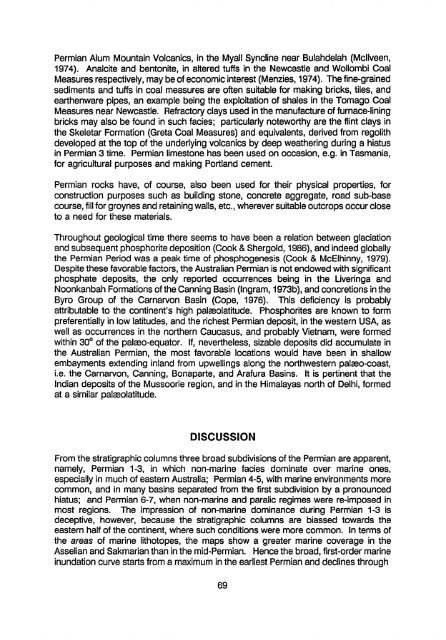II II II II II - Geoscience Australia
II II II II II - Geoscience Australia
II II II II II - Geoscience Australia
You also want an ePaper? Increase the reach of your titles
YUMPU automatically turns print PDFs into web optimized ePapers that Google loves.
Permian Alum Mountain Volcanics, in the Myall Syncline near Bulandelah (McIlveen,<br />
1974). Analcite and bentonite, in altered tuffs in the Newcastle and Wollombi Coal<br />
Measures respectively, may be of economic interest (Menzies, 1974). The fine-grained<br />
sediments and tuffs in coal measures are often suitable for making bricks, tiles, and<br />
earthenware pipes, an example being the exploitation of shales in the Tomago Coal<br />
Measures near Newcastle. Refractory clays used in the manufacture of furnace-lining<br />
bricks may also be found in such facies; particularly noteworthy are the flint clays in<br />
the Skeletar Formation (Greta Coal Measures) and equivalents, derived from regolith<br />
developed at the top of the underlying volcanics by deep weathering during a hiatus<br />
in Permian 3 time. Permian limestone has been used on occasion, e.g. in Tasmania,<br />
for agricultural purposes and making Portland cement.<br />
Permian rocks have, of course, also been used for their physical properties, for<br />
construction purposes such as building stone, concrete aggregate, road sub-base<br />
course, fill for groynes and retaining walls, etc., wherever suitable outcrops occur close<br />
to a need for these materials.<br />
Throughout geological time there seems to have been a relation between glaciation<br />
and subsequent phosphorite deposition (Cook & Shergold, 1986), and indeed globally<br />
the Permian Period was a peak time of phosphogenesis (Cook & McElhinny, 1979).<br />
Despite these favorable factors, the <strong>Australia</strong>n Permian is not endowed with significant<br />
phosphate deposits, the only reported occurrences being in the Liveringa and<br />
Noonkanbah Formations of the Canning Basin (Ingram, 1973b), and concretions in the<br />
Byro Group of the Carnarvon Basin (Cope, 1976). This deficiency is probably<br />
attributable to the continent's high palmolatitude. Phosphorites are known to form<br />
preferentially in low latitudes, and the richest Permian deposit, in the western USA, as<br />
well as occurrences in the northern Caucasus, and probably Vietnam, were formed<br />
within 30 0 of the palmo-equator. If, nevertheless, sizable deposits did accumulate in<br />
the <strong>Australia</strong>n Permian, the most favorable locations would have been in shallow<br />
embayments extending inland from upwellings along the northwestern palmo-coast,<br />
i.e. the Carnarvon, Canning, Bonaparte, and Arafura Basins. It is pertinent that the<br />
Indian deposits of the Mussoorie region, and in the Himalayas north of Delhi, formed<br />
at a similar palmolatitude.<br />
DISCUSSION<br />
From the stratigraphic columns three broad subdivisions of the Permian are apparent,<br />
namely, Permian 1-3, in which non-marine facies dominate over marine ones,<br />
especially in much of eastern <strong>Australia</strong>; Permian 4-5, with marine environments more<br />
common, and in many basins separated from the first subdivision by a pronounced<br />
hiatus; and Permian 6-7, when non-marine and paralic regimes were re-imposed in<br />
most regions. The impression of non-marine dominance during Permian 1-3 is<br />
deceptive, however, because the stratigraphic columns are biassed towards the<br />
eastern half of the continent, where such conditions were more common. In terms of<br />
the areas of marine lithotopes, the maps show a greater marine coverage in the<br />
Asselian and Saknnarian than in the mid-Permian. Hence the broad, first-order marine<br />
inundation curve starts from a maximum in the earliest Permian and declines through<br />
69

















